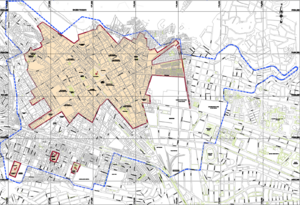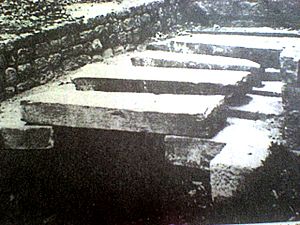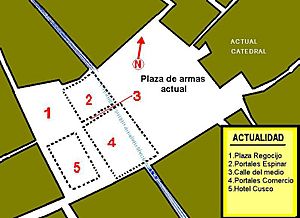Plaza de Armas (Cusco) facts for kids
Quick facts for kids Plaza Mayor del Cusco |
|
|---|---|
| Huacaypata | |

National Cultural Heritage and World Heritage Site
|
|

Location map
|
|
| Type | Public square |
| Location | |
| Area | 28728 square meters |
| Created | 11th century |
| Founder | Legendary establishment of the city by Manco Capac |
| Status | Open |
| Other information | Adjacent roads, from the Cathedral in a clockwise direction:
Calle Triunfo Calle Santa Catalina Angosta Calle Loreto Calle Mantas Calle del Medio Calle Espaderos Calle Plateros Calle Procuradores Calle Suecia Calle Cuesta del Almirante |

Plaza Mayor del Cusco at present time
|
|
| Location | |
|---|---|
| Type | Main Square |
|
|
The Plaza de Armas of Cusco is a famous public square in the city of Cusco, Peru. It's right in the historic center of the city. This square has been the main gathering place for the town since before the Spanish founded the city in 1534.
Scientists have studied the area and found that it used to be a swamp. The Saphy River, which is now hidden underground, flowed through it. During the time of the Inca Empire, this swamp was drained. It was then turned into the main administrative, religious, and cultural hub of the Inca capital. It was where important ceremonies took place and where the Inca army celebrated its victories.
After the Spanish took over, they changed it into a plaza (square). They built Catholic churches and grand houses on top of the old Inca palaces. Many important people in Peruvian history, like Túpac Amaru II, lost their lives in this square in 1781. Other heroes of Peru's fight for independence, such as Bernardo Tambohuacso and Mateo Pumacahua, also faced their end here.
Today, the Plaza de Armas is still the heart of modern Cusco. It's surrounded by many tourist restaurants, jewelry shops, and travel agencies. The same Catholic churches built during the colonial period are still there. These include the Cusco Cathedral and the Iglesia de la Compañía de Jesús. These two churches are among the most important buildings in the city.
Since 1972, the square has been part of Cusco's Monumental Zone. This means it's a Historic Monument of Peru. Also, in 1983, UNESCO declared it a World Cultural Heritage Site. This was because it is part of the historic center of Cusco.
Contents
History
From Swamp to Square
When Manco Cápac first arrived in the Cusco valley, he settled near a swamp. This swamp was between two streams, Saphy and Tullumayo. He chose this spot because it was safe from other groups. Manco Capac built his palace, called Colcampata, at the base of the Sacsayhuaman hill. The city grew up around this swamp.
Later, Sinchi Roca, Manco Capac's son, started to dry out the swamp. He used earth brought from the mountains. Much later, Pachacuti finished the job. He completely covered the swamp with sand brought all the way from the coast.
The Inca Empire's Center
During the Inca period, the main square was much bigger than it is today. It included the current Plaza de Armas (then called Huacaypata) and the entire area of the present-day Plaza Regocijo (then Cusipata). It also covered the "Hotel Cusco" and the blocks between Calle Espaderos, Calle del Medio, and Calle Mantas.
The Saphy River, which is now a covered sewer, used to flow through these blocks and Calle del Medio. This river divided the square into two main parts. The square was the religious and administrative center of the Inca Empire. It was also the main point of the Inca road system. Around the square were the palaces of important Incas like Pachacuti, Huayna Capac, and Viracocha Inca.
Inca Palaces Around the Square
The square was surrounded by the palaces of the Inca rulers. There were also plots of land set aside for future palaces.
- Pachacuti's palace was called Qasana. It was on the northwest side of the square. Today, this is where the Portal de Panes is located.
- Huayna Capac's palace was called Amaru Cancha. It was on the southeast side. Today, the Iglesia de la Compañía, the Portal de la Compañía, and the University Auditorium stand here.
- The palace of Inca Viracocha, called Sunturwasi, is now where the Cusco Cathedral is.
- The current Portal de Harinas was once the Korakora palace.
- The Portal de Carrizos was the old Acllawasi.
During the Inca period, almost all major Inca festivals were held here. These included Inti Raymi, Huarachicuy, and Capac Raymi. It was also where big fairs took place. The square was where the Inca army celebrated its victories. Victorious Inca armies would be welcomed in the Plaza de Armas. They would show off their war treasures and prisoners as a sign of their triumph.
Spanish Conquest and Changes
When the Spanish arrived in Cusco, they first stayed in the Inca palaces around the square. Later, they built grand colonial houses, cathedrals, and churches on top of the Inca palace ruins.
In 1545, a leader named Polo de Ondergardo ordered the removal of the beach sand from the square's floor. This sand was used to help build the Cusco Cathedral. In 1555, another leader, Sebastián Garcilaso de la Vega, allowed buildings to be constructed in the middle of the Huacaypata. This created the blocks we see today between Calle Espaderos, Calle Del Medio, Calle Mantas, Calle Heladeros, and Calle Espinar. It also formed the current Plaza de Armas, Plaza Regocijo, Plaza Espinar, and the Hotel de Turistas. During the time of the Viceroyalty, this hotel building was used as a mint to make coins.
The Plaza Today
Today, the Plaza de Armas is a lively place. It's surrounded by many tourist restaurants, jewelry shops, travel agencies, and souvenir stores. The two main churches, the Cathedral and the Iglesia de la Compañía, are still used for worship. When services are not happening, they become museums that visitors can explore for a fee.
Most of the buildings around the square still have some Inca walls at their base. However, the colonial style is what you mostly see. This area is very important, making it the most expensive part of Cusco. Rent for a shop here can be over 1500 dollars per month. In the early 2000s, several well-known companies opened their first stores in the Plaza de Armas. These include the Peruvian company Bembos and international brands like McDonald's, Starbucks, and KFC.
The square continues to be the site of many traditional Cusco festivals. These include Santiraticuy, Corpus Christi, and Easter. It also hosts modern celebrations like Fiestas Patrias, Fiestas del Cusco, and New Year's Eve. Sometimes, the Plaza de Armas is used for free concerts, parades, and political gatherings.
See also
 In Spanish: Plaza de Armas del Cuzco para niños
In Spanish: Plaza de Armas del Cuzco para niños



